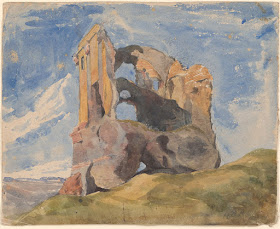 |
| Hercules Brabazon Brabazon Tomb in the Campagna ca. 1845-48 watercolor Morgan Library, New York |
"In the present drawing, an architectural ruin monumentally fills the composition, which is set in the Roman Campagna. Following his graduation with honors in the Mathematical Tripos from Trinity College, Cambridge, Brabazon rejected reading law at the Inns of Court in favor of becoming an artist. He subsequently spent three years in Rome training, and it is possible that the present sheet dates to that time. The drawing is signed with Brabazon's conventional inscription H.B.B. Sir Frederick Wedmore summarized Brabazon's career as an aristocratic and amateur artist by quipping that Brabazon was "a country gentleman who at seventy years old made his debut as a professional artist and straightway became famous."
– curator's notes from the Morgan Library, New York
 |
| Hercules Brabazon Brabazon Distant view of Rome from the Campagna ca. 1845-48 watercolor Morgan Library, New York |
 |
| Jean-Achille Benouville Landscape in the Roman Campagna 1859 watercolor Morgan Library, New York |
 |
| John Francis Campbell Copy drawing of a View in the Roman Campagna 1841 watercolor National Galleries of Scotland |
 |
| John Francis Campbell Copy drawing of a View in the Roman Campagna 1841 watercolor National Galleries of Scotland |
 |
| George Smith Temple of Bacchus and the church of St Agnese, Campagna di Roma 1832 watercolor British Museum |
"This drawing was one of a group from a sketchbook the artist left or gave to Richard Redgrave and which records his travels around Italy. He had been brought up by the uncle of Redgrave, with whom he sketched at the British Museum and enrolled at the Royal Academy in 1826. Smith won the gold medal for mythological composition three years later and in 1830 went to Rome to study. He lived in Palazzo Poniatowski and struggled to make a living as a drawing master between travelling and studying in Venice and Naples. The present work was made in the company of the Welsh artist Penry Williams who had settled in Rome in 1826. Smith wrote to Redgrave in 1833 that his sketches were, "more valuable to myself than I believe they will be to other persons."
– curator's notes from the British Museum
 |
| Giovanni Costa Ancient Tress in the Roman Campagna ca. 1850-60 watercolor National Gallery of Art, Washington DC |
 |
| Johann Adam Klein Tivoli and the Roman Campagna 1820 watercolor National Gallery of Art, Washington DC |
 |
| Joseph Mallord William Turner Moonlight over the Campagna 1819 watercolor, gouache Tate Gallery |
"Like many drawings within this sketchbook, the composition has been executed over a washed grey background, although in this instance the artist has extensively worked up the design with further watercolor and gouache. Turner varies his application of paint considerably, ranging from wet on wet for the touches of pink in the top right-hand corner of the sky, to drier patches of gouache creating the textured areas of foliage in the foreground. He has also created pale highlights by scratching through the paint to reveal the paper beneath, principally to describe the white disc above the horizon and the reflected light cast on the water beneath. This has been described as 'Moonrise', although it could equally represent the rising or setting sun. There is no evidence of under-drawing and despite the naturalistic appearance of the scene it is likely that Turner painted it from memory or imagination."
– curator's notes from the Tate Gallery
 |
| Bartolomeo Pinelli Peasant Family in the Campagna 1807-08 watercolor Cooper Hewitt, Smithsonian Design Museum |
 |
| Bartolomeo Pinelli Two Shepherds in the Campagna 1807-08 watercolor Cooper Hewitt, Smithsonian Design Museum |
 |
| Bartolomeo Pinelli Woman and Boy passing a Gentleman seated among Ruins in the Campagna 1807 watercolor Cooper Hewitt, Smithsonian Design Museum |
 |
| Jean-Charles-Joseph Rémond View of the Roman Campagna ca. 1858-71 watercolor British Museum |
 |
| Franz Albert Venus Campagna Landscape on the Via Flaminia 1869 watercolor Getty Museum, Los Angeles |
"A talented landscapist, Venus rendered this panoramic view which he saw on the Via Flaminia, the ancient road that linked Rome to northern Italy, cutting its way across the mountainous central region of the peninsula. Ruins of Roman tower tombs, visible in the distance, are bathed in the soft, wintry light. Venus executed this watercolor on the spot, applying the medium with wonderful looseness and coloristic clarity. The composition is structured horizontally through contrasting tonal areas, and the whole conveys the artist's fascination with the unique atmosphere of the countryside."
– curator's notes from the Getty Museum